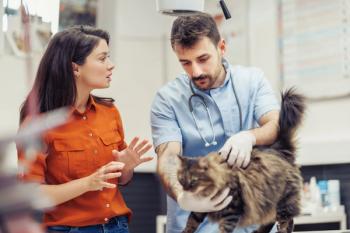
Don't forget the smaller farms
"It doesn't make any difference. I'll soon be out of business anyway."?This statement came in response to a suggestion I made to a client while still in practice. I was surprised. The person speaking was a friend as well as a client, and I knew he ran a profitable operation. He was usually upbeat and optimistic, but this morning there was irritation in his voice.
"It doesn't make any difference. I'll soon be out of business anyway."
This statement came in response to a suggestion I made to a client whilestill in practice. I was surprised. The person speaking was a friend aswell as a client, and I knew he ran a profitable operation. He was usuallyupbeat and optimistic, but this morning there was irritation in his voice.
He obviously had more to say, so I just waited. "Every farm magazineI pick up says that if we don't milk at least 500 cows, we can't survive.We have to get big or get out. Us little guys are not 'efficient', so wecan't possibly make it."
Now I knew what was bothering him. Smaller operators often feel ignored,threatened, and a little scared as they witness the trend to larger farms.
Remaining competitive
I have become somewhat of an advocate for "family dairy farms."This is not to say that I am opposed to larger operations, but I believesmaller units can prosper as well. I use the term "family dairy farm"to describe businesses where members of one family own the cows and performmost of the labor. Cow numbers are typically between 50 and 80, with somemilking as many as 100.
Most dairy practitioners still service a lot of family farms. I believethese clients offer a real opportunity to deliver production medicine services.Indeed, the fact that they do feel somewhat ignored means they appreciateanyone who views them as important. If you can provide suggestions thathelp them remain competitive, then you become very valuable to them.
The key term here is "remain competitive," which means theymust be continually making changes to become more efficient. "Efficient"is a term which many dairy farmers get tired of hearing, but it is trulythe key to survival for them. They must become more efficient, because thatis what is happening in their industry.
Keep in mind that becoming more efficient simply means that they generatemore output (usually pounds of milk), per unit of input (labor, feed, cowsor capital). They can become more efficient either by shipping more milkwith the same input, or shipping the same amount with less input.
How to improve efficiency
There are many ways that family farms can improve efficiency, and someare extremely creative in doing so. In most cases, they need to focus onthree factors. These are:
1. Milk as many cows as possible, without exceeding the number they canproperly manage. Defining this number is much more art than science.
2. Get as much milk per cow as possible, while maintaining health andreasonable feed costs. Forage quality and cow comfort are important factorsin making this one happen.
3. Keep investment per cow as low as possible. This means sharing equipmentwith neighbors and using custom harvesters.
These same factors are applicable to large farms, but smaller units mayneed more coaching to help them understand them. One of the most successfulfamily farms I know demonstrated all three of these concepts.
In 1987, when I first started working with them, they milked 44 cowsand had a 22,000 pound herd average. Ten years later, cow numbers had risento 78, with 28,000 pounds of milk per cow. All labor was performed by thehusband, wife, and minor children. Equipment was shared with a neighbor. As you can see, the amount of milk shipped from this family doubled in10 years. They had obviously become more efficient.
Milk shipping
Another guideline I use when working with family farms is that they needto ship as much milk as large farms can ship per worker. This will allowthe family unit to draw the same income as larger farms must pay each employeein salary, taxes, and benefits, assuming that they can match up in othercategories. The main disparity will be in depreciation, which although a"non-cash" expense, must still be considered. The more equipmentthey can share, and the more they use custom operators, the better theywill match up with larger farms on depreciation.
A reasonable goal for family farms is to generate $1,000 per cow as anoperating profit. This means how much money is left after paying all routinecash expenses except interest. How this remaining money gets allocateddepends on debt service and capital replacement. (These two numbers canbe substituted for depreciation when looking at cash flow).
Both of these values can vary a great deal, but $400 and $200 respectivelyare "not uncommon'. By subtraction we get $400 per cow per year leftover for family living expenses.
Using these guidelines, 60 cows and 22,000 pounds of milk shipped percow kind of emerge as minimum numbers.
That generates $24,000 for family living. Add to that the value of "perks"that the farm operation provides (a second vehicle, meat and milk, housing,insurance) and the number looks a little more attractive. Obviously, ifthe same family can milk 80 or 100 cows, then things look more secure.
Really attractive?
Some will be quick to point out that $24,000 plus perks is hardly anattractive income when compared to the total hours that husband, wife andchildren must devote to the operation. True enough, and that will discouragemany. But there are families for whom the family farm lifestyle is veryattractive. My point is that they can live on these income levels, and buildequity at the same time. We should not dismiss them lightly.
Last fall, Agway sponsored a series of meetings that focused on businessmanagement of family dairy farms. We packed the room each day, and got veryhigh reviews from those who attended. Part of their appreciation was simplythat someone paid attention to them. The lesson for dairy practitionersis to include the smaller farms in your production medicine programs, andhelp them in ways that truly improve operating profit.
Dr. Gardner is director of animal health and herd economicsat Keystone Agway. He also consults with dairy practitioners on practicemanagement.
Newsletter
From exam room tips to practice management insights, get trusted veterinary news delivered straight to your inbox—subscribe to dvm360.






